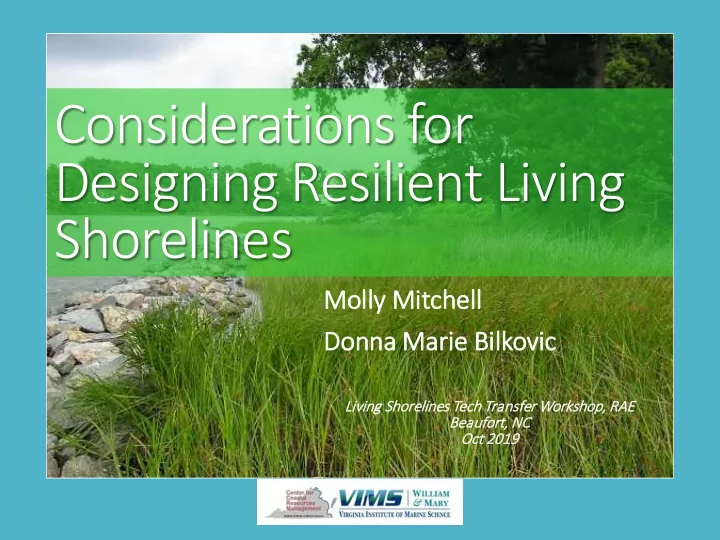

Considerations for Designing Resilient Living Shorelines Molly M Mitchell Don Donna M Marie B Bilkovic Living S Sho horeline nes T Tech T h Trans nsfer W Worksho hop, p, R RAE Beaufo fort, N NC Oct 2019 2019
Sea level “report cards” for the US https://www.vims.edu/research/products/slrc/compare/index.php
Marshes are dynamic resilient To keep pace with sea level: a) Marshes migrate b) Marshes accrete Δ Water Levels Controlled by: SLR Land elevation Modified by human activities & decisions Mitchell & Bilkovic. 2019. Δ CO 2 Controlled by: Plant production Δ Water Levels Sediment availability Sediment respiration Δ Temperature
Photo by Skip Stiles Photo by Karen Duhring https://appliedecologistsblog.com/2019/05/01/can-living-shorelines-survive-the-rising-seas/#comments
Photo by Skip Stiles Photo by Karen Duhring https://appliedecologistsblog.com/2019/05/01/can-living-shorelines-survive-the-rising-seas/#comments
Migration Prospects in Chesapeake Bay Low – marsh projected to decline overtime due to typically high elevations in the surrounding lands Medium – opportunities for marsh migration are limited by development Best – Best likelihood for marsh migration Conservation priorities for promoting marsh migration “DNH_marsh_conservation_2050” shapefile. Developed by Center for Coastal Resources Management, Virginia Institute of Marine Science. Nov 2018. Contact M. Mitchell (molly@vims.edu) or J. Herman (herman@vims.edu).
Migration potential in living shoreline design What to plant for best migration potential? MSL 2050 2 ft MSL 2016 Focus planting in the upper elevations of the tidal range Dubois, K. 2017. Overcoming barriers of Living Shoreline Use and Success Preserve riparian land where elevations are suitable for marsh migration Don’t mow!
Accretion potential, also affect by siting • Sediment supply coming from Plants (organic) • Watershed • Adjacent lands (via runoff or tidal • waters) Marsh front edge erosion • • Current CB management goals are to restrict sediment in 2050-2060 waters Today Fagherazzi et al. 2013. Oceanography , 26 (3): 70-77.
Enhancing accretion in living shoreline design Marsh plant stem density, stem height, and aboveground biomass influence the marsh’s ability to trap sediments and attenuate wave energy Natural Marsh 800 Marsh plant density Marsh-sill (stems/m2) 600 400 200 0 Spartina alterniflora Spartina patens Bilkovic and Mitchell, 2017 Marsh-sill low marsh stem counts lower than natural fringing marshes; high marsh similar No evident trajectory across age of marsh sampled (1-11 yrs)
Enhancing accretion in living shoreline design Living sills add a dynamic component to wave energy attenuation Growth on structures reduces wave transmission as oysters grow Hall et al. 2017 Growing Living Shorelines and Ecological Services via Coastal Bioengineering. In Living Shorelines: The Science and Management of Nature-based Coastal Protection, CRC Press Sills increase in height, width and density over time
When natural dynamic components are compromised… Thin layer deposition artificially maintains elevations in the tidal frame Considered a beneficial use of dredge material and might help marshes stay within the tidal frame Might improve grass density leading to increased accretion Need more evidence of long-term usefulness
Dynamic designs are the path to resilience Site te allow for landward marsh migration with rising sea levels • don’t mow the marsh as it migrates • Enhan ance use sills (rock or oyster) *with windows* to encourage sediment accretion • encourage tall, dense plant growth • encourage mussel/oyster growth on marsh and sills • Main intain in when marshes can’t migrate, and natural sediment supply is low, add thin layers • of sediment to maintain elevations remove invasive species • Commu mmunicate – property owners need to know that living shorelines aren’t static
Thank you! molly@vims.edu
Recommend
More recommend